
Owning a pool is a fantastic way to add value to your home and enjoy sunny days, but it also comes with the responsibility of ensuring safety, especially when it comes to young children and pets. A secure pool fence isn’t just a precaution—it’s a legal requirement in many areas, aimed at reducing the risk of drowning accidents. This guide provides a comprehensive look at pool fence safety inspections and outlines seven key steps to ensure your pool fence meets compliance standards and provides effective protection.
Why Pool Fence Safety is Crucial
According to the Centers for Disease Control and Prevention (CDC), drowning is one of the leading causes of unintentional injury-related death in children ages 1-4. A properly installed and maintained pool fence acts as a critical barrier, preventing young children and unauthorized individuals from accessing the pool area unsupervised. Most local laws mandate pool fencing for residential pools, with specific height and gate requirements.
Beyond legal compliance, pool fence inspections can also lower your liability as a pool owner. Insurance companies may even offer discounts on your policy if your pool fence passes a professional safety inspection.
The 7 Key Steps to Ensure Pool Fence Compliance
1. Understand Local Regulations and Codes
Different states, counties, and municipalities have their own regulations for pool fencing. These regulations dictate the minimum height, gap spacing, gate mechanisms, and materials permitted for a pool fence. In most areas, a pool fence must be at least 4 feet high, though some jurisdictions may require a height of 5 or 6 feet.
Make sure to research your local codes or consult a pool fence professional who is familiar with the specific requirements in your area. Failure to meet these local regulations can lead to fines and other penalties, so it’s essential to start with a clear understanding.
2. Measure Your Fence Height and Gap Spacing
A compliant pool fence must be tall enough to prevent children from climbing over, typically standing at least 4 to 5 feet high. During your inspection, measure the fence height at several points to confirm it meets this requirement across the entire perimeter. Ensure that vertical gaps between fence pickets or slats are narrow enough (generally no more than 4 inches apart) to prevent a child from squeezing through.
The bottom of the fence should also be close to the ground, usually within 2 inches, to prevent small children or pets from crawling underneath. These measurements are essential to ensure that your fence serves as a reliable barrier.
3. Inspect the Gate Mechanism and Latching System
One of the most important aspects of a pool fence is the gate, which should be self-closing and self-latching. The gate’s latch must be at a height out of reach of small children—usually around 54 inches from the ground. It should also open outward from the pool area, creating an additional safety measure if a child attempts to push it open.
During inspection, open and release the gate several times to confirm that it closes and latches automatically each time. A faulty latch or loose hinges can render the gate ineffective, so make sure that all moving parts are in good working condition.
4. Examine the Fence Material for Durability and Stability
Pool fences can be made of various materials, such as metal, glass, wood, or mesh. Regardless of the material, it must be sturdy and able to withstand regular wear and tear, including exposure to water and weather conditions. Metal fences should be rust-free, wooden fences should be free from rot and termites, and glass panels should be free from cracks.
Check for signs of wear, such as loose screws, rust, or rotting wood. Regular maintenance, like tightening screws or treating wood, can help keep your pool fence secure and durable for years to come.
5. Eliminate Climbable Objects Near the Fence
A critical but sometimes overlooked aspect of pool fence safety is the surrounding area. Ensure that there are no climbable objects, such as planters, chairs, or toys, within 3 feet of the fence. Even low shrubbery or tree branches can be used by a child to climb over the fence.
If there are trees near your pool fence, keep branches trimmed to a safe distance. The goal is to create a clear zone around the fence, making it difficult for children or pets to access the pool area unsupervised.
6. Check for Potential Entrapment Hazards
Entrapment hazards refer to any gaps or openings in the fence where a child could get stuck. For instance, if you have a fence with decorative features like scrollwork, make sure these do not create spaces where a child’s head, limbs, or clothing could become caught.
Inspect the entire length of the fence to identify any areas that could pose a risk. Modifying these spots to reduce the chance of entrapment can help you maintain a safer environment around your pool.
7. Schedule Routine Professional Inspections
Even with a diligent self-inspection, it’s wise to schedule routine professional inspections. Licensed pool inspectors are trained to identify issues that might be overlooked by homeowners. They also stay up-to-date on local regulations, so they can advise if any changes in laws require adjustments to your fence.
Routine inspections ensure that your fence remains in compliance over time and give you peace of mind. In many areas, inspections are required annually, while in others, they are optional but highly recommended.
Benefits of Regular Pool Fence Safety Inspections

- Enhanced Safety
- A secure fence is the most effective way to prevent accidental drownings and pool-related accidents.
- Compliance with Legal Requirements:
- Regular inspections ensure that your pool fence meets local codes, preventing fines or legal complications.
- Lower Insurance Premiums:
- A compliant pool fence may qualify you for reduced insurance rates, as it reduces liability.
- Preservation of Property Value:
- Homes with secure, well-maintained pools and fences are more appealing to buyers, which can benefit resale value.
- Peace of Mind:
- Knowing your pool area is secure lets you relax and enjoy your pool with family and friends without constant worry.
DIY vs. Professional Pool Fence Inspections
While you can perform a preliminary inspection yourself, professional inspections offer a more thorough and reliable evaluation. Inspectors have specialized knowledge and tools to assess the structural integrity, compliance with codes, and overall safety of your pool fence. A professional can also provide a detailed report, which can be helpful if you need to show proof of compliance to insurers or local authorities.
If you’re considering a DIY inspection, make sure you have access to a measuring tape, level, and checklist of local pool fence codes. Check each element of the fence carefully, especially the gate’s self-closing mechanism and latch. Even if you conduct your own inspection, it’s a good idea to have a professional review your fence annually.
Conclusion
Pool fence safety inspections are essential for both legal compliance and the protection of children, pets, and guests. By following the seven key steps—understanding local regulations, measuring for compliance, checking the gate mechanism, inspecting materials, clearing climbable objects, removing entrapment hazards, and scheduling routine professional inspections—you can ensure your pool remains a safe and enjoyable space.
Regular pool fence inspections aren’t just a precaution—they’re a commitment to safety, compliance, and peace of mind. By taking proactive steps to inspect and maintain your pool fence, you not only protect loved ones but also uphold your responsibility as a pool owner, creating a secure environment that meets legal standards and safeguards everyone who enjoys your pool area. Contact us today to know more!

